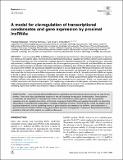A model for cis-regulation of transcriptional condensates and gene expression by proximal lncRNAs
Author(s)
Natarajan, Pradeep; Shrinivas, Krishna; Chakraborty, Arup K
DownloadPublished version (22.70Mb)
Publisher with Creative Commons License
Publisher with Creative Commons License
Creative Commons Attribution
Terms of use
Metadata
Show full item recordAbstract
Long noncoding RNAs (lncRNAs) perform several important functions in cells including cis-regulation of transcription. Barring a few specific cases, the mechanisms underlying transcriptional regulation by lncRNAs remain poorly understood. Transcriptional proteins can form condensates via phase separation at protein-binding loci (BL) on the genome (e.g., enhancers and promoters). lncRNA-coding genes are present at loci in close genomic proximity of these BL and these RNAs can interact with transcriptional proteins via attractive heterotypic interactions mediated by their net charge. Motivated by these observations, we propose that lncRNAs can dynamically regulate transcription in cis via charge-based heterotypic interactions with transcriptional proteins in condensates. To study the consequences of this mechanism, we developed and studied a dynamical phase-field model. We find that proximal lncRNAs can promote condensate formation at the BL. Vicinally localized lncRNA can migrate to the BL to attract more protein because of favorable interaction free energies. However, increasing the distance beyond a threshold leads to a sharp decrease in protein recruitment to the BL. This finding could potentially explain why genomic distances between lncRNA-coding genes and protein-coding genes are conserved across metazoans. Finally, our model predicts that lncRNA transcription can fine-tune transcription from neighboring condensate-controlled genes, repressing transcription from highly expressed genes and enhancing transcription of genes expressed at a low level. This nonequilibrium effect can reconcile conflicting reports that lncRNAs can enhance or repress transcription from proximal genes.
Date issued
2023-07Department
Massachusetts Institute of Technology. Department of Chemical Engineering; Massachusetts Institute of Technology. Department of Physics; Massachusetts Institute of Technology. Institute for Medical Engineering & Science; Ragon Institute of MGH, MIT and Harvard; Massachusetts Institute of Technology. Department of ChemistryJournal
Biophysical Journal
Publisher
Elsevier BV
Citation
Natarajan, Pradeep, Shrinivas, Krishna and Chakraborty, Arup K. 2023. "A model for cis-regulation of transcriptional condensates and gene expression by proximal lncRNAs." Biophysical Journal, 122 (13).
Version: Final published version